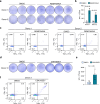Upstream open reading frame translation enhances immunogenic peptide presentation in mitotically arrested cancer cells
- PMID: 40866359
- PMCID: PMC12391379
- DOI: 10.1038/s41467-025-63405-2
Upstream open reading frame translation enhances immunogenic peptide presentation in mitotically arrested cancer cells
Abstract
Mitosis is a critical phase of the cell cycle and a vulnerable point where cancer cells can be disrupted, causing cell death and inhibiting tumor growth. Challenges such as drug resistance persist in clinical applications. During mitosis, mRNA translation is generally downregulated, while non-canonical translation of specific transcripts continues. Here, we show that mitotic cancer cells redistribute ribosomes toward the 5' untranslated region (5' UTR) and beginning of the coding sequence (CDS), enhancing translation of thousands of upstream open reading frames (uORFs) and upstream overlapping open reading frames (uoORFs). This mitotic induction of uORF/uoORF enriches human leukocyte antigen (HLA) presentation of non-canonical peptides on the surface of cancer cells after mitotic inhibitor treatment. Functional assays indicate these epitopes provoke cancer-cell killing by T cells. Our findings highlight the therapeutic potential of targeting uORF/uoORF-derived epitopes with mitotic inhibitors to enhance immune recognition and tumor cell elimination.
© 2025. The Author(s).
Conflict of interest statement
Competing interests: The authors declare no competing interests
Figures






References
-
- Park, J.-E., Yi, H., Kim, Y., Chang, H. & Kim, V. N. Regulation of poly(A) tail and translation during the somatic cell cycle. Mol. Cell62, 462–471 (2016). - PubMed
MeSH terms
Substances
Grants and funding
- 759579/EC | EU Framework Programme for Research and Innovation H2020 | H2020 Priority Excellent Science | H2020 European Research Council (H2020 Excellent Science - European Research Council)
- 504774163/Deutsche Forschungsgemeinschaft (German Research Foundation)
- 545215964/Deutsche Forschungsgemeinschaft (German Research Foundation)
LinkOut - more resources
Full Text Sources
Medical
Research Materials

